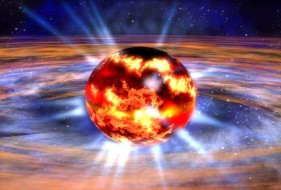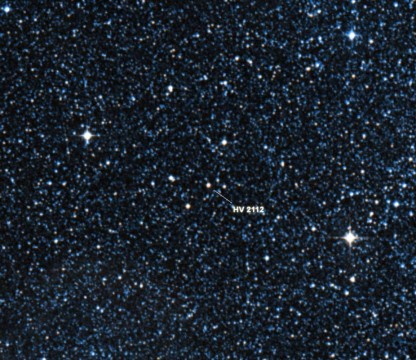Since Thorne-Żytkow Objects were proposed forty years ago, no one has actually seen one of these exotic stellar hybrids – until now.

NASA
After nearly four decades of searching, astronomers might finally have found a candidate Thorne- Żytkow Object (TŻO), a bizarre and, until now, purely theoretical star. This stellar hybrid forms in a rare interaction that crams a neutron star inside a massive companion.
TŻOs have remained elusive because they appear nearly identical to ordinary red supergiant stars. But in a recent survey of red supergiants in the Milky Way and Magellanic Clouds, Emily Levesque (University of Colorado, Boulder) and colleagues identified a candidate in the Small Magellanic Cloud by its unique chemical properties.
A pair of massive, tightly orbiting stars sets the stage for the weird merger. The more massive star explodes in a supernova first, leaving behind a neutron star remnant. According to one model, the remaining massive star exhausts its fuel supply and begins to swell, ultimately engulfing the neutron star. An alternative model suggests that the force of the initial supernova actually launches the neutron star into the middle of its supergiant companion.
Either way, a TŻO will look similar to the red supergiant star that has engulfed its neutron star partner. But unlike normal red supergiants, the boiling atmospheres of TŻOs dredge up thermonuclear products that form on the surface of the hot, embedded neutron star. The recently discovered TŻO candidate, dubbed HV 2112, initially appeared to be a lone M-type red supergiant, but with a mass much greater than the upper limit for giant stars. The real clincher came in the form of HV 2112’s spectrum, which showed lines from lithium, molybdenum, and rubidium in its atmosphere in a combination unique to the thermonuclear processes at work in TŻOs.

Digital Sky Survey/Center de Données Astronomiques de Strasbourg
But a few features in HV 2112’s spectrum weren’t expected. For example, the amount of lithium and heavy metals in HV 2112’s atmosphere are not as extreme as predicted by TŻO models, which could mean that HV 2112 is a just-formed TŻO. Also, some elements show up in the spectrum that aren’t associated with TŻO models; however, there is hope that more advanced models for stellar convective envelopes will eventually clear up the origin of these unexpected enhancements.
Currently, HV 2112 seems to meet the basic criteria of a TŻO, and if it’s the real deal, it promises exciting developments for stellar astronomy. Not only is there an entirely new model for some stellar interiors, but there’s also a new way to produce the heavy metals that ultimately form exoplanets.
Kip Thorne, who first proposed the TŻO model with Anna Żytkow in 1975, states that HV 2112 looks like a strong TŻO candidate. But Levesque urges caution in the buzz of discovery: “We’re calling [HV 2112] a ‘candidate’ for a reason. Claiming that we’ve found a totally new model of star is an extraordinary claim, it requires extraordinary proof.” Bolstering the claim will involve both theoretical and observational work, as astronomers create more detailed models of stellar interiors, as well as find other TŻO candidates in the red supergiant population.
Just when you think we know all there is to know about the cosmos, astronomers discover another mystery. Read about the greatest quandaries facing astronomy in our special issue, Astronomy's 60 Greatest Mysteries.
 9
9
Comments
Justin S
June 18, 2014 at 7:17 pm
Neutron stars are small but have intense surface gravity. It would seem to me that it would pull in gasses from the surrounding red giant at a prodigious rate, being essentially a vacuum a few hundred miles in diameter, much larger than the neutron star itself. It would seem to me that the neutron star could suck in the bulk of the mass of the red giant in a geologically short period of time. I’m skeptical of this scenario.
You must be logged in to post a comment.
Peter Wilson
June 20, 2014 at 2:16 pm
Maybe because the neutron star is so hot? Seems like it would be a “candidate” for collapsing into a black hole. Some kind of explanation would be helpful.
You must be logged in to post a comment.
John Anderson
June 20, 2014 at 5:36 pm
Same question came to mind as I read it. Doesn't seem like a gravitationally stable configuration.
I also am confused by the reference to Li as a heavy metal.
One practical question: does anyone know how to pronounce Anna Zytow's name? (besides Anna)
You must be logged in to post a comment.
Jim-Baughman
June 20, 2014 at 9:05 pm
A red giant is not a "vacuum a few hundred miles in diameter". They generally are many tens of millions of miles in diameter, and only a virtual vacuum at their outermost fringes. The deep interior is still very hot and very dense, and I think it's this that interacts with the neutron star to create, thermonuclearly, the heavy metals mentioned in the article.
You must be logged in to post a comment.
Jim-Baughman
June 20, 2014 at 8:51 pm
Regarding this sentence-- "The real clincher came in the form of HV 2112’s spectrum, which showed lines from the heavy metals lithium, molybdenum, and rubidium..." Lithium is not a heavy metal, in fact it doesn't even contribute to "metallicity" since lithium is found in brown dwarfs, created through sub-nuclear-ignition processes.
You must be logged in to post a comment.
June 21, 2014 at 7:34 am
There is no standard definition of "heavy metal."
One of the definitions of heavy metal merely requires toxicity. Lithium, therefore, can be considered to be a heavy metal. For this specific discussion, I would agree that lithium should not be referred to as being a heavy metal, especially since it is the element other than helium and hydrogen that existed before the first star formed.
You must be logged in to post a comment.
Lou
June 23, 2014 at 8:12 am
The neutron star's surface will be millions to billions of degrees - the thermonuclear reactions occuring on its surface should produce enough radiation pressure to prevent runaway accretion of gas.
You must be logged in to post a comment.
John Anderson
June 24, 2014 at 11:18 pm
I wonder if an accretion disk could form around the neutron star. Also, I don't know if the radiation pressure is strong enough to prevent accumulation of mass. We have observed many real neutron stars and they aren't that bright anywhere along the spectrum except along the magnetic poles, correct? Have the experts modelled this TŻO object? Nature keeps providing amazing things to study.
You must be logged in to post a comment.
Mike
June 23, 2014 at 1:29 pm
I would think there would also be a shell of white-dwarf-like material surrounding the neutron star. As you go further from the neutron star core, there would be a transition region where gravity is too strong for ordinary matter to exist but not strong enough to overcome the electron degeneracy pressure.
You must be logged in to post a comment.
You must be logged in to post a comment.